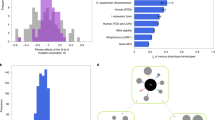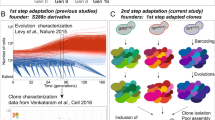Abstract
Populations evolving in constant environments exhibit declining adaptability. Understanding the basis of this pattern could reveal underlying processes determining the repeatability of evolutionary outcomes. In principle, declining adaptability can be due to a decrease in the effect size of beneficial mutations, a decrease in the rate at which they occur, or some combination of both. By evolving Escherichia coli populations started from different steps along a single evolutionary trajectory, we show that declining adaptability is best explained by a decrease in the size of available beneficial mutations. This pattern reflected the dominant influence of negative genetic interactions that caused new beneficial mutations to confer smaller benefits in fitter genotypes. Genome sequencing revealed that starting genotypes that were more similar to one another did not exhibit greater similarity in terms of new beneficial mutations, supporting the view that epistasis acts globally, having a greater influence on the effect than on the identity of available mutations along an adaptive trajectory. Our findings provide support for a general mechanism that leads to predictable phenotypic evolutionary trajectories.
This is a preview of subscription content, access via your institution
Access options
Access Nature and 54 other Nature Portfolio journals
Get Nature+, our best-value online-access subscription
$29.99 / 30 days
cancel any time
Subscribe to this journal
Receive 12 digital issues and online access to articles
$119.00 per year
only $9.92 per issue
Buy this article
- Purchase on Springer Link
- Instant access to full article PDF
Prices may be subject to local taxes which are calculated during checkout




Similar content being viewed by others
References
Wiser, M. J., Ribeck, N. & Lenski, R. E. Long-term dynamics of adaptation in asexual populations. Science 342, 1364–1367 (2013).
Couce, A. & Tenaillon, O. A. The rule of declining adaptability in microbial evolution experiments. Front. Genet. 6, 99 (2015).
Kondrashov, F. A. & Kondrashov, A. S. Multidimensional epistasis and the disadvantage of sex. Proc. Natl Acad. Sci. USA 98, 12089–12092 (2001).
Gong, L. I. & Bloom, J. D. Epistatically interacting substitutions are enriched during adaptive protein evolution. PLoS Genet 10, e1004328 (2014).
Da Silva, J., Coetzer, M., Nedellec, R., Pastore, C. & Mosier, D. E. Fitness epistasis and constraints on adaptation in a human immunodeficiency virus type 1 protein region. Genetics 185, 293–303 (2010).
Ortlund, E. A., Bridgham, J. T., Redinbo, M. R. & Thornton, J. W. Crystal structure of an ancient protein: evolution by conformational epistasis. Science 317, 1544–1548 (2007).
Kryazhimskiy, S., Rice, D. P., Jerison, E. R. & Desai, M. M. Global epistasis makes adaptation predictable despite sequence-level stochasticity. Science 344, 1519–1522 (2014).
Salverda, M. L. M. et al. Initial mutations direct alternative pathways of protein evolution. PLoS Genet. 7, e1001321 (2011).
Chou, H. H., Chiu, H. C., Delaney, N. F., Segre, D. & Marx, C. J. Diminishing returns epistasis among beneficial mutations decelerates adaptation. Science 332, 1190–1192 (2011).
MacLean, R. C. Predicting epistasis: an experimental test of metabolic control theory with bacterial transcription and translation. J. Evol. Biol. 23, 488–493 (2010).
Khan, A. I., Dinh, D. M., Schneider, D., Lenski, R. E. & Cooper, T. F. Negative epistasis between beneficial mutations in an evolving bacterial population. Science 332, 1193–1196 (2011).
Rokyta, D. R. et al. Epistasis between beneficial mutations and the phenotype-to-fitness map for a ssDNA virus. PLoS Genet. 7, e1002075 (2011).
Draghi, J. A. & Plotkin, J. Selection biases the prevalence and type of epistasis along adaptive trajectories. Evolution 67, 3120–3131 (2013).
Greene, D. & Crona, K. The changing geometry of a fitness landscape along an adaptive walk. PLoS Comp. Biol. 10, e1003520 (2014).
Blanquart, F., Achaz, G., Bataillon, T. & Tenaillon, O. Properties of selected mutations and genotypic landscapes under Fisher’s geometric model. Evolution 68, 3537–3554 (2014).
Shah, P., McCandlish, D. M. & Plotkin, J. B. Contingency and entrenchment in protein evolution under purifying selection. Proc. Natl Acad. Sci. USA 112, E3226–E3235 (2015).
Hegreness, M., Shoresh, N., Hartl, D. & Kishony, R. An equivalence principle for the incorporation of favorable mutations in asexual populations. Science 311, 1615–1617 (2006).
Barrick, J. E., Kauth, M. R., Strelioff, C. C. & Lenski, R. E. Escherichia coli rpoB mutants have increased evolvability in proportion to their fitness defects. Mol. Biol. Evol. 27, 1338–1347 (2010).
Perfeito, L., Fernandes, L., Mota, C. & Gordo, I. Adaptive mutations in bacteria: high rate and small effects. Science 317, 813–815 (2007).
Kryazhimskiy, S., Tkacik, G. & Plotkin, J. B. The dynamics of adaptation on correlated fitness landscapes. Proc. Natl Acad. Sci. USA 106, 18638–18643 (2009).
Barrick, J. E. et al. Genome evolution and adaptation in a long-term experiment with Escherichia coli . Nature 461, 1243–1247 (2009).
Lang, G. I. et al. Pervasive genetic hitchhiking and clonal interference in forty evolving yeast populations. Nature 500, 571–574 (2013).
Traverse, C. C., Mayo-Smith, L. M., Poltak, S. R. & Cooper, V. S. Tangled bank of experimentally evolved Burkholderia biofilms reflects selection during chronic infections. Proc. Natl Acad. Sci. USA 110, E250–E259 (2013).
Woods, R. J. et al. Second-order selection for evolvability in a large Escherichia coli population. Science 331, 1433–1436 (2011).
Burch, C. L. & Chao, L. Evolvability of an RNA virus is determined by its mutational neighbourhood. Nature 406, 625–628 (2000).
Dykhuizen, D. E., Dean, A. M. & Hartl, D. L. Metabolic flux and fitness. Genetics 115, 25–31 (1987).
Woods, R., Schneider, D., Winkworth, C. L., Riley, M. A. & Lenski, R. E. Tests of parallel molecular evolution in a long-term experiment with Escherichia coli . Proc. Natl Acad. Sci. USA 103, 9107–9112 (2006).
Orr, H. A. The distribution of fitness effects among beneficial mutations. Genetics 163, 1519–1526 (2003).
Zhang, W. et al. Estimation of the rate and effect of new beneficial mutations in asexual populations. Theor. Pop. Biol. 81, 168–178 (2012).
Satterwhite, R. S. & Cooper, T. F. Constraints on adaptation of Escherichia coli to mixed-resource environments increase over time. Evolution 69, 2067–2078 (2015).
R Core Team R: A language and environment for statistical computing ( R Foundation for Statistical Computing, 2015).
Goslee, S. C. & Urban, D. L. The ecodist package for dissimilarity-based analysis of ecological data. J. Stat. Softwar 22, v022i07 (2007).
Pinheiro, J., Bates, D., DebRoy, S., Sarkar, D. & R Core Team. nlme: Linear and nonlinear mixed effects models v.3.1-121 (R Foundation for Statistical Computing, 2015); http://CRAN.R-project.org/package=nlme
Acknowledgements
This work was supported by a grant from the National Science Foundation (DEB-1253650 to T.F.C).
Author information
Authors and Affiliations
Contributions
T.F.C. conceived and designed the study, and performed analyses. A.W., D.M.D., R.S.S., C.D.A. and D.M.S. performed the experiments. All authors contributed to the writing of the paper.
Corresponding author
Ethics declarations
Competing interests
The authors declare no competing financial interests.
Supplementary information
Supplementary Information
Supplementary Tables 1–5; Supplementary Figures 1–6 (PDF 2165 kb)
Rights and permissions
About this article
Cite this article
Wünsche, A., Dinh, D., Satterwhite, R. et al. Diminishing-returns epistasis decreases adaptability along an evolutionary trajectory. Nat Ecol Evol 1, 0061 (2017). https://doi.org/10.1038/s41559-016-0061
Received:
Accepted:
Published:
DOI: https://doi.org/10.1038/s41559-016-0061
This article is cited by
-
A parallel glycolysis provides a selective advantage through rapid growth acceleration
Nature Chemical Biology (2024)
-
Global epistasis in plasmid-mediated antimicrobial resistance
Molecular Systems Biology (2024)
-
Gene birth in a model of non-genic adaptation
BMC Biology (2023)
-
Epistasis and evolution: recent advances and an outlook for prediction
BMC Biology (2023)
-
Evolvability-enhancing mutations in the fitness landscapes of an RNA and a protein
Nature Communications (2023)



